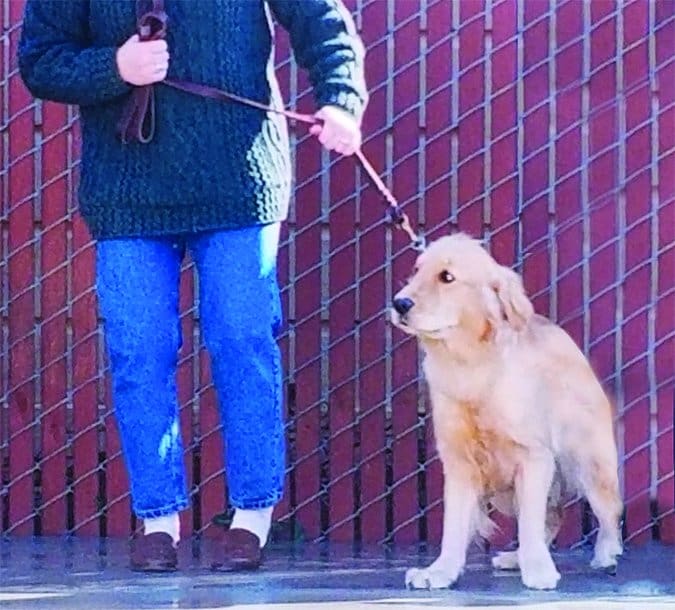Perhaps you’re thinking about taking your adolescent out-of-control dog, or your dog with significant behavior issues, to a board-and-train (B&T) facility, where they will work with her for a few short weeks and hand her back all perfect. Right? Wait a minute. What sounds like a perfect solution to your dog’s behavior and training challenges is fraught with danger. Remember that something that sounds too good to be true, often is.
Don’t get me wrong. There are certainly some fantastic B&T professionals who can indeed help you with your dog when you feel like you’ve hit a wall. It’s just that they are few and far between while the scary ones seem to be everywhere.
When you leave your dog in someone else’s hands and walk away, you are taking a significant risk that they will do bad things to your dog when you are no longer there to intervene. There is virtually no regulation in the dog-training industry in the United States, and even so-called “positive trainers” can do bad things to your dog when you aren’t there.

The Bad and the Ugly of the Dog Training World
There are a variety of B&T trainers who fall into the “bad and ugly” category. They are:
The Criminal Scammers. A tragic news article caught my eye recently about a B&T provider who was refusing to answer phone calls from worried owners. When authorities were called in, they found dead and other seriously neglected dogs on the premises. (And this isn’t the first time I’ve seen this happen.)
The Shock Jocks. These are B&T providers who are proud of the fact that they use shock collars along with other pain-causing tools and physical force and punishment to “dominate” their clients’ dogs. They insist that dogs need to know who is boss, and the only way to achieve this is with the use of force.
If there is one good thing about these folks, it’s that you can spot them a mile away and know immediately that you would never leave your beloved dog in their hands.
Balancing Act. Then there are the so-called “balanced trainers” who profess to using positive reinforcement as a first resort, but who are willing to use pain, force, and coercion when they feel a dog “needs” it. These trainers can be very good at talking you into thinking that force is sometimes necessary as a backup plan. (It’s not.) Some are even convinced they can use a shock collar as “positive reinforcement.” (It’s not. Ever.) Also, knowing they are willing to use those tools and methods, you will have no idea how much they are getting used when you’re not there to supervise.
Positive Pretenders. These are the really sneaky ones. They claim to be “positive” when in fact they aren’t. Sometimes they think they are positive because they give the dog a treat after they jerk on the collar – or because they are less punitive than they used to be. Some trainers say they are “positive,” but they don’t ever use food or treats as reinforcers. Food is considered a “primary reinforcer” – valuable to most dogs. If a trainer never uses treats, she is needlessly foregoing the most powerful reinforcer in the force-free training toolbox. She will likely be less successful and/or use coercion in her training. Trainers who pretend to be force-free are not likely to do anything overtly forceful in your presence. This is why you need to get good referrals from trusted friends and professionals and do your own research, too (more on that below).
Signs of a Good Board and Train Facility
If you are in a situation where you feel compelled to pursue a B&T option for your dog, it is critically important that you do in-depth research before agreeing to allow someone to work with your dog.
The following are due-diligence tips from well-respected trainers who offer Board & Train services themselves:
Leslie Clifton, CPDT-KA, CPCT, PMCT, is a force-free trainer who offers limited B&T services in Putnam County, Florida.
Christine Danker, CPDT-KA, KPA-CTP, PMCT3, of Albany County, New York, is a force-free trainer who has had considerable experience with B&T services.
1. Find a trainer who uses only reward-based methods.
Preferably this is a trainer referred to you by another training professional you trust, or a trusted friend who has had already used this service and is satisfied.
2. Check out the trainer’s website.
Look for professional certifications that support force-free training. Look for incongruities, such as trainers who call themselves “positive” but photos on their websites show dogs in prong collars, choke chains, and/or shock collars. Not a good choice. Instead, find a trainer who walks the walk as well as she talks the talk.
3. Visit the place where your dog will be staying.
Is it safely and securely fenced? Double fencing is ideal, with fence in good repair, and latches in good working condition. Some trainers have B&T dogs live in their own homes, with their own canine and human family members. (These trainers generally take a very limited number of B&T clients, sometimes only their own already-existing clients.) If your dog will be kenneled, are the kennels clean and well-maintained, with appropriate climate controls?
4. Verify what kinds of tools and methods the trainers use.
Confirm these in writing in your B&T contract. Flat collars, martingales, harnesses, treats, praise, and toys: all good. Any mention of “e-collars” or one of the many euphemisms for “shock” (such as “e-touch,” “stim,” “remote,” and “tickle”) should send you running for the door. If more than one trainer will be working with your dog, confirm that each trainer shares your philosophy of force-free handling and training.
5. Ask how many dogs the trainer takes at a time.
When you visit the property, make sure the number of dogs present seems reasonable for the facilities and number of trainers available to work with the dogs.
6. Inquire if your dog will be taken off premises, and if so, for what reason(s)?
Emergency vet visits, yes. Group play at the dog park or dog-pack walks should be a definite no. Will your dog be transported safely in a crate? If your dog needs veterinary care, will the trainer take your dog to your own vet, or to hers? (Yours is preferred, of course, but distance may be too great if you are traveling far to find an excellent B&T facility.)
7. Ask what skills will be worked on, and again, confirm the methods that will be used.

Have the trainer give a demonstration but be ready to assertively interrupt if she begins to use any coercive methods, such as leash jerks, a loud voice, or physically forcing the dog into position.
8. Look at the dogs currently in the trainer’s care.
Do they appear happy and relaxed? Quiet does not always mean stress-free; they may be intimidated. Look for dogs to move happily toward the trainer. Dogs who move slowly and/or with a lowered body posture and/or lowered head can indicate fear, deference, or appeasement. These are sometimes a sign that aversives are being used in training and other interactions with the dogs.
If dogs are barking and jumping at kennel fences and kennel doors, how does the trainer handle the situation? There should be no yelling, squirt bottles, penny cans, or other aversives used to quiet barking dogs. Rather, puzzle toys and other environmental enrichment tools should be in place to help keep dogs quiet, as well as management (physical barriers to reduce stimulation).
9. Ask for references from previous clients.
Contact and interview those clients in detail, asking specific questions about their dogs’ behavior before and after the training,and what tools and methods were used. Ask, too, what they loved about the trainer and her results, as well as anything that they were less than happy with.
Protective Board and Train Paperwork
If all looks good and you are ready to proceed, ask to see the provider’s intake forms. Ideally, the provider wants a lot of information about your dog! There should be rigorous intake forms, including a dog behavior questionnaire, a pet profile and medical history, a board and train contract, and a veterinary release form (should your dog become ill).
– Make clear that you are to be contacted immediately if your dog becomes ill; include this in your contract.
– Be prepared to sign a contract that states exactly where the dog will stay, what skills will be trained, what tools and methods will be used, and how the dog will interact (if at all) with other dogs on the premises.
Ask for the following to be included in the contract: that you will be sent daily updates and photos, that follow-up training notes and videos will be provided, and that emails or phone calls will be returned if you have questions, both during your dog’s stay and after she comes home. If the trainer doesn’t offer a contract, or these specifics are not included, ask for it to be created.
– Understand that you will still need to work with your dog when she comes home.
B&T can’t fix everything! Follow-up lessons with the owner should be part of the package and included in the contract.
– Insist on writing “owner visitations” into the contract.
You want to ensure your right to drop by the facility at any time, to protect your dog from the criminal scammers, if your dog is going to be at B&T for more than a week or two.
– Call in the authorities if even one of your visits is refused.
Remember that B&T professionals can’t just wave a magic wand and fix your dog forever. If they could, they would all be millionaires! They can help manage and retrain behavioral challenges, but you are still responsible for managing and training your dog. They can teach you how to live successfully with your dog, but you’ll still need to work with your dog yourself.
Because your dog likely has a prior history of being reinforced for the unwanted behaviors at home, she may well try them again, even if she learned new good-manners behaviors at the B&T. Make sure your B&T trainer gives you good information on how to help her generalize the desired behaviors to your home environment and is willing to continue giving you guidance along the way.
Trainers Comment on “Board and Train” Experiences
We asked several trainers how they feel about board and train practices. Here are some of their comments:
Trish Ryan, PMCT-Certified Positive Trainer, PPG, APDT
For Paw Drive, Manchester, NJ
A friend of mine who is involved with rescue wanted to send one of their rescue dogs to a B&T that was recommended by someone and was purportedly “positive.” She sent me the link and the first thing I looked at was the photo gallery. I asked her to tell me what was wrong with the pictures. She didn’t understand; she didn’t see anything wrong. I told her to take another look; every single dog was wearing a choke collar!
Also, in a Q and A section about their dog training program, they said, “Our training techniques are all very humane. Every trainer at [Name Redacted]’s Dog Training Company is here because they love dogs … they are our passion. Therefore, we have found over years of dog-training experience that the most effective training method is positive reinforcement – not food or treats!”
This is obviously not a true positive-training facility.
Christine Michaud, CTC, PMCT, CPDT-KA
Family Dog Training LLC, Fairfax, VA
I just started to offer B&T and I take only one puppy at a time, so it’s super small scale. But I wanted to offer an alternative to the local boot camps that take puppies at 16 weeks, kennel them, shock them to teach sit, then send them home as temporarily obedient zombies.
I keep the puppies in my home, living as part of my family, not only so I can love and care for them the way their own family would, but also so they get experience in a home environment. I send them home happy, socialized, loved, and well-mannered for the family environment in which they will live, using toys, play, and meals to teach. I video their training and play sessions and send daily video to the family. I wish I could take 100 puppies!
Karlene Turkington, CPDT-KA
Pawsitive Results Dog Training, Opelika, AL
I’ve had a couple of dogs with issues from B&T. One was a client’s dog, a huge Rottie. I was supposed to work with her on aggression issues and general obedience. On my first day training her, I was reviewing the cues she supposedly already knew. When I asked her to “down” she growled at me and ran across the room. She repeated this behavior twice more.
I asked the owners if they could explain why she did this. They could not – but about two years earlier they had sent her to a B&T. She didn’t know the “down” behavior before, nor would she “down” on cue when she came back, but ever since she’d come back, whenever they would ask her to down she behaved in just this way – so, of course, they had quit asking her.
I feel certain she had been forced into a “down” at the B&T and the growling was a sign of her fear about this. So instead of asking her to down, I simply started “capturing” the behavior (this is when a handler rewards the dog every time she happens to perform the behavior, until she does the behavior on purpose in order to get the reward; then and only then does the handler add a cue). Within a few sessions, she would down with no growl, because she really liked hotdogs!
Bob Ryder, PMCT-3, CPDT-KA
Pawsitive Transformations, Bloomington, IL
I’ve had only one board and train experience in my eight-plus years as a professional trainer. A young family was overwhelmed with an extremely energetic and intelligent Lab puppy. Mom, Dad, and three young kids were busy with careers, school, and sports, and barely had a moment left over for puppy training and exercise. The puppy spent long hours in a kennel and was a tornado of desperation and impulsive needs.
After half a dozen in-home training/coaching sessions, the family knew they needed more help and asked if I would board and train their puppy while they traveled for vacation. The puppy initially spent two weeks with us, then another week later during the summer when the family traveled again. During her time with me, the puppy was an all-star pupil. She was eager to learn and made meteoric progress.
When her family returned from their travels and picked her up, she went home with a “straight A” report card, an hour of in-home instruction in management and training games, and a detailed, written list of all her tricks and the signals to cue them. I could not have been more proud of the puppy or my efforts with her.
A few weeks later, I returned to their home for a follow-up session and found that the puppy had reverted to all of the fractious behaviors she practiced before our board and train project. The family had not changed their approach with her at all, and we were back to square one. It was beyond discouraging.
Soon after, the mom suffered a broken leg, dad was at wits’ end, the kids were very disenchanted, and the puppy was back in the kennel much of the time. The mom asked whether I would consider adopting the puppy. Daisy has been with us ever since and is now a model of happy, self-controlled, good manners and cooperation.
I’d probably never do B&T again. The more experience I accumulate in training and behavior modification, the clearer it is to me that there’s no substitute for a family or individual being able to understand their dog’s physical and mental needs and to build a skill-set for positive-reinforcement training. Training a dog is not the same as installing an app on a smart phone or changing the tires on a car. Good training means helping the family and the dog build a relationship based on good information, skills, and mutual trust; it takes commitment that board and train can’t replace.
Author Pat Miller, CBCC-KA, CPDT‑KA, is WDJ’s Training Editor. She and her husband Paul live in Fairplay, Maryland, site of her Peaceable Paws training center. Miller is also the author of many books on positive training. Her newest is Beware of the Dog: Positive Solutions for Aggressive Behavior in Dogs.




